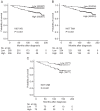Evaluation of Ki67 expression across distinct categories of breast cancer specimens: a population-based study of matched surgical specimens, core needle biopsies and tissue microarrays
- PMID: 25375149
- PMCID: PMC4223011
- DOI: 10.1371/journal.pone.0112121
Evaluation of Ki67 expression across distinct categories of breast cancer specimens: a population-based study of matched surgical specimens, core needle biopsies and tissue microarrays
Abstract
Introduction: Tumor cell proliferation in breast cancer is strongly prognostic and may also predict response to chemotherapy. However, there is no consensus on counting areas or cut-off values for patient stratification. Our aim was to assess the matched level of proliferation by Ki67 when using different tissue categories (whole sections, WS; core needle biopsies, CNB; tissue microarrays, TMA), and the corresponding prognostic value.
Methods: We examined a retrospective, population-based series of breast cancer (n = 534) from the Norwegian Breast Cancer Screening Program. The percentage of Ki67 positive nuclei was evaluated by visual counting on WS (n = 534), CNB (n = 154) and TMA (n = 459).
Results: The median percentage of Ki67 expression was 18% on WS (hot-spot areas), 13% on CNB, and 7% on TMA, and this difference was statistically significant in paired cases. Increased Ki67 expression by all evaluation methods was associated with aggressive tumor features (large tumor diameter, high histologic grade, ER negativity) and reduced patient survival.
Conclusion: There is a significant difference in tumor cell proliferation by Ki67 across different sample categories. Ki67 is prognostic over a wide range of cut-off points and for different sample types, although Ki67 results derived from TMA sections are lower compared with those obtained using specimens from a clinical setting. Our findings indicate that specimen specific cut-off values should be applied for practical use.
Conflict of interest statement
Figures




References
-
- Perou CM, Sorlie T, Eisen MB, van de Rijn M, Jeffrey SS, et al. (2000) Molecular portraits of human breast tumours. Nature 406: 747–752. - PubMed
-
- Hugh J, Hanson J, Cheang MC, Nielsen TO, Perou CM, et al. (2009) Breast cancer subtypes and response to docetaxel in node-positive breast cancer: use of an immunohistochemical definition in the BCIRG 001 trial. Journal of clinical oncology: official journal of the American Society of Clinical Oncology 27: 1168–1176. - PMC - PubMed
Publication types
MeSH terms
Substances
LinkOut - more resources
Full Text Sources
Other Literature Sources
Medical

